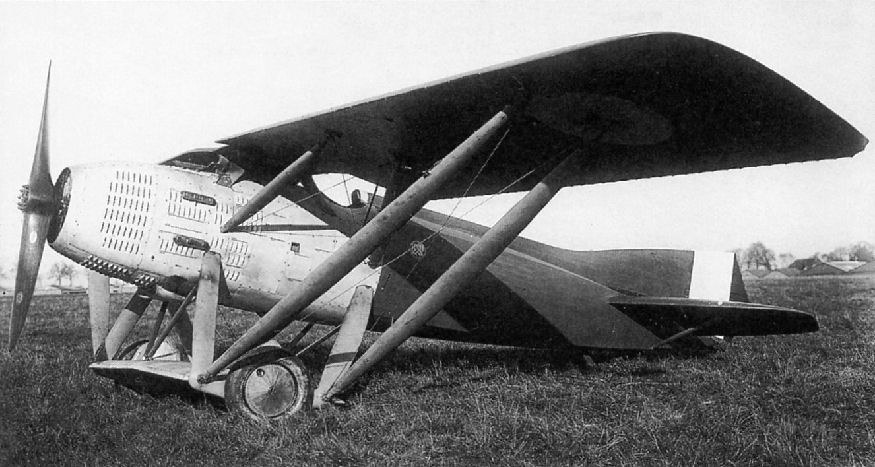Buscaylet (самолеты фирмы "Buscaylet")
<...>
В 1923 году ВВС Франции выпустили требования к перспективному одноместному истребителю, на которые "Buscaylet" ответила самолетом Buscaylet-Bechereau 2 (ВВ.2), спроектированным Луи Бешеро на базе Letord-Bechereau 2. Главным отличием от предшественника стала замена подкосов с широкой хордой с несущими поверхностями между стойками шасси и замена высокорасположенного крыла из двух консолей единым подкосным крылом. Фюзеляж стал круглого сечения с длинным гаргротом, переходившим в киль малого удлинения. Радиатор установлен перед мотором, капот снабжен многочисленными вентиляционными щелями. Крыло с небольшой стреловидностью по передней кромке снабжено по всему размаху элеронами и вырезом для лучшего обзора из кабины в центральной части. Дополнительная аэродинамическая поверхность установлена между четырьмя мощными подкосами под фюзеляжем, к которым также крепятся оси колес шасси. Хвостовая опора - костыль.
Первый полет ВВ.2 выполнил в 1924 году. На испытаниях самолет показал низкие летные данные и плохую управляемость. Дальнейшие работы по одноместному варианту свернули, но ставший главным конструктором "Salmson" Луи Бешеро продолжил работы по двухместному варианту самолета.
<...>
ТАКТИКО-ТЕХНИЧЕСКИЕ ХАРАКТЕРИСТИКИ
Buscaylet-Bechereau 2
Тип: одноместный истребитель
Силовая установка: один звездообразный мотор Salmson 18Cm мощностью 500 л. с. (373 кВт)
Летные характеристики: максимальная скорость на высоте 3000 м - 250 км/ч
Масса: пустого 1350 кг; максимальная взлетная 1758 кг
Размеры: размах крыла 14,00 м; длина 10,00 м; высота 3,00 м; площадь крыла 39,00 м'
Вооружение (предполагаемое): два неподвижных 7,7-мм пулемета Vickers в носовой части фюзеляжа.
Показать полностьюShow all
Flight, December 1926
The Paris Aero Show 1926
SALMSON-BECHEREAU (S.R.A.P.)
THE S.R.A.P. (Societe pour la Realisation d’Avions Prototypes) is a new firm with offices in Paris, which has secured the technical services of M. Bechereau, the well-known onetime designer of the Deperdussin and Spad aeroplanes.
The S.R.A.P. will exhibit a Salmson-Bechereau C.2 two-seater fighter (500 h.p. Salmson C.18), the fuselage of a Bechereau mail aeroplane, a Bechereau shock-absorbing system for Goliath aeroplanes, and a patented joy-stick.
The Salmson-Bechereau C.2 Two-Seater Fighter.- The Salmson-Bechereau Two-seater fighter is a strut-braced monoplane, having two outer wing struts, which are fixed to the undercarriage and an intermediate Warren truss. The construction is of conventional lines, consisting essentially of a wire-braced timber framework. The wing struts are faired steel tubes. The wing is covered with fabric except at the leading edge, where multi-ply is used to give added strength. The fuselage is built up on four main longerons and plywood formers, over which a false work of spruce stringers is fixed to give the fuselage a good streamline. The engine compartment as well as the pilot's cockpit are covered with sheet aluminium; the rest of the fuselage as well as the tail unit are fabric-covered.
The under-carriage struts are plywood frames of V type.
Specification.- Engine, 500 h.p. Salmson C.18; span, 14-60 m.; length, 10 m.; height, 3 m.; wing area, 35 sq. m.; weight empty, 1,558 kg.; fuel load, 292 kg.; crew (two), 160 kg.; armament and equipment, 350 kg. weight loaded, 2,360 kg.
Official Performances (S.T.Ae. Tests)
Altitude: 3,000 4,000 5,000 6.000 6,700
Speed, km. p.h. 220 215 209 200
Climb, mins. 9' 13'51" 20'12" 31'40" 47'38"
Ceiling, 7.150 m.
<...>
FROM the side view of the Salmson-Bechereau C.2, published in our issue of December 2, it was difficult to realise the complication of the strutting which a closer inspection of this machine at the show revealed. .M. Bechereau, it may be recollected, is an old hand at designing aeroplanes, having been responsible for the design of the Deperdussin monoplanes in the very early days of aviation, and during the war of the early Spads. With an experience like that behind him, one is justified in expecting from a designer a really fine piece of work, but frankly the machine exhibited on this stand could scarcely be so described as regards its design. One of our sketches this week shows the general scheme of the wing bracing, and it will be seen that this is of such a nature that there must be a good deal more strut area offering resistance than need be incorporated in a biplane with orthodox bracing. Unless the demand is, for some service reason not entirely obvious, a parasol monoplane at all costs, it is difficult to guess what was in the designer's mind. The fuselage is of excellent streamline form, and that the machine must be aerodynamically efficient in spite of its excessive amount of strutting, seems obvious from the official performance figures published in our December 2 issue, according to which the speed at 10,000 ft. is 220 km./hr. (136-6 m.p.h.). One cannot help thinking that with the same fuselage neatly put into a biplane structure an even better performance would have been obtained.
<...>
Показать полностьюShow all



